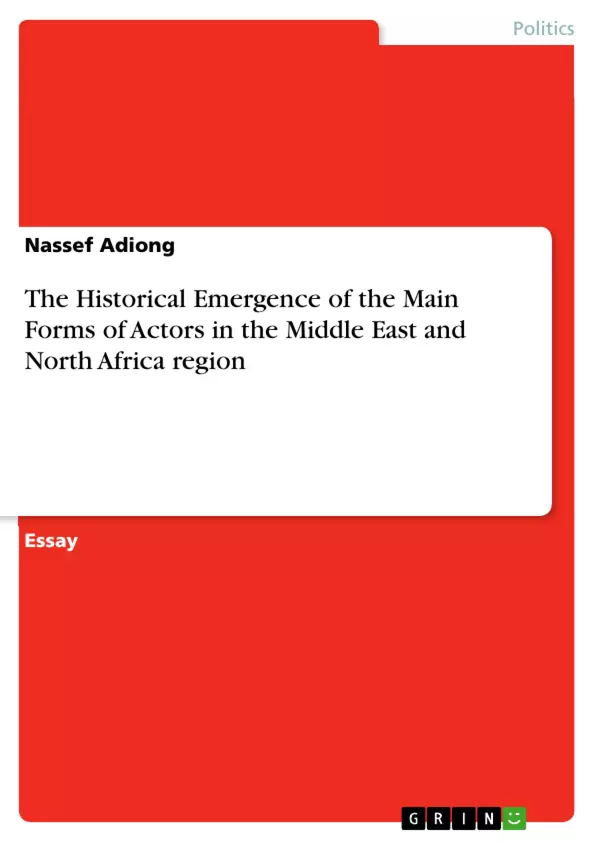This paper will focused on the historical antecedents of actors involved in creating and developing Middle East and North Africa (MENA) region, and what are the differences amongst them. The timeline will begin in the aftermath of the Ottoman Empire that materialized into the advent of the European colonizations and birth of nation-states.
Revolutions spark all over the Fertile Crescent, when the Arabs knew that the twilight of the Ottomans are now commencing. According to Aroian and Mitchell (1984, p. 164), from the 1919 Syrian resistance that was affirmed by their French protectors through the provisions laid down in the League of Nations has led to the Iraqi revolt of 1920, which was resembled by British India and Egypt in the days of Lord Cromer because they were inspired by the Syrian revolution.
The premise is that all of the Arabian Peninsula is interconnected to each other with regards to their struggle for freedom and independence. Halpern (1963, p. 256) contends that the San Remo Conference, in addition to confirming allied plans for Iraq and Syria, granted Britain a mandate that combined Palestine and Transjordan (the area across or east of the Jordan River).
Prior to the partition, Palestine had been part of greater Syria, while present-day Jordan was viewed as part of both Syria and Arabia. Ottoman administrative divisions had not included the terms Palestine and Jordan. When Britain obtained the mandate for Palestine at San Remo, the intention was that a national home for Jews should be set up in Palestine, but it was stated explicitly that not all conditions of the mandate would necessarily apply to the entire area.
Inhaltsverzeichnis (Table of Contents)
- The Historical Emergence of the Main Forms of Actors in the Middle East and North Africa region
- The Rise of Nation-States and the Legacy of the Ottoman Empire
- The San Remo Conference and the Mandate for Palestine
- The Zionist Movement and the Establishment of Israel
- The Egyptian Struggle for Independence
- The Rise of Reza Khan and the Pahlavi Dynasty in Iran
- The Kingdom of Saudi Arabia: The Rise of Ibn Saud
- The Northern African Territories: Libya and Morocco
Zielsetzung und Themenschwerpunkte (Objectives and Key Themes)
This paper aims to explore the historical development of key actors in the Middle East and North Africa (MENA) region, focusing on the period following the decline of the Ottoman Empire. The paper analyzes the emergence of nation-states and the role of European colonialism in shaping the political landscape of the region. It examines the struggles for independence and self-determination in various countries, exploring the interplay of internal and external forces.
- The legacy of the Ottoman Empire and its impact on the emergence of nation-states in the MENA region.
- The role of European colonialism and the formation of mandates in shaping the political landscape of the region.
- The struggles for independence and self-determination in various MENA countries, including Palestine, Egypt, Iran, and Saudi Arabia.
- The impact of international actors and regional powers on the political dynamics of the MENA region.
- The emergence of key actors and their influence on the development of the MENA region.
Zusammenfassung der Kapitel (Chapter Summaries)
The paper begins by outlining the historical context of the MENA region, tracing its origins back to the decline of the Ottoman Empire. It then explores the impact of European colonialism and the formation of mandates, focusing on the case of Palestine. The paper further examines the emergence of the Zionist movement and the establishment of Israel, analyzing the complexities of this process. It then delves into the Egyptian struggle for independence, highlighting the role of internal and external forces in shaping this struggle. The paper further examines the rise of Reza Khan and the Pahlavi dynasty in Iran, tracing the dynamics of Iranian politics in the early 20th century. Finally, it explores the emergence of the Kingdom of Saudi Arabia, focusing on the rise of Ibn Saud and his unification of the Arabian Peninsula.
Schlüsselwörter (Keywords)
This paper focuses on key themes such as the emergence of nation-states, European colonialism, the struggle for independence, the role of key actors, and the impact of international forces on the MENA region. The paper examines the historical development of the region, highlighting the role of key actors in shaping its political landscape. The key concepts explored include the legacy of the Ottoman Empire, mandates, Zionism, and the rise of nationalist movements.
- Citation du texte
- Researcher Nassef Adiong (Auteur), 2008, The Historical Emergence of the Main Forms of Actors in the Middle East and North Africa region , Munich, GRIN Verlag, https://www.grin.com/document/121024



